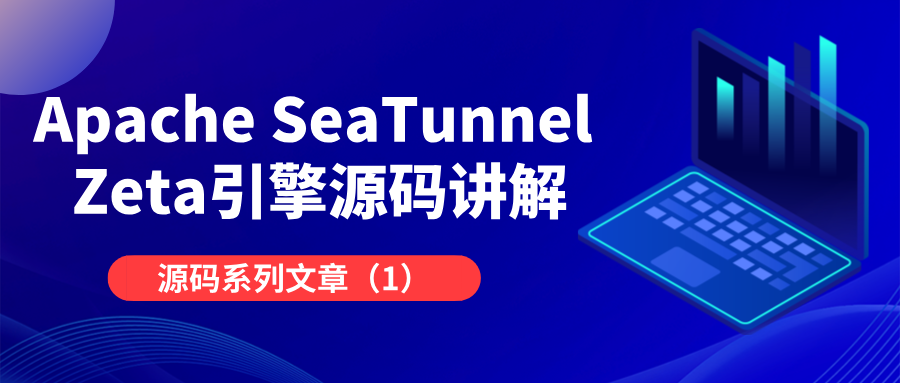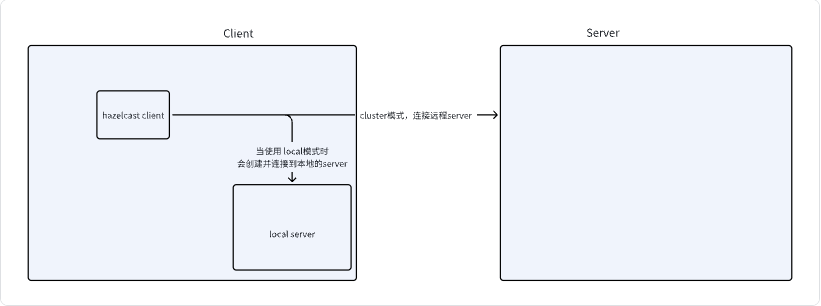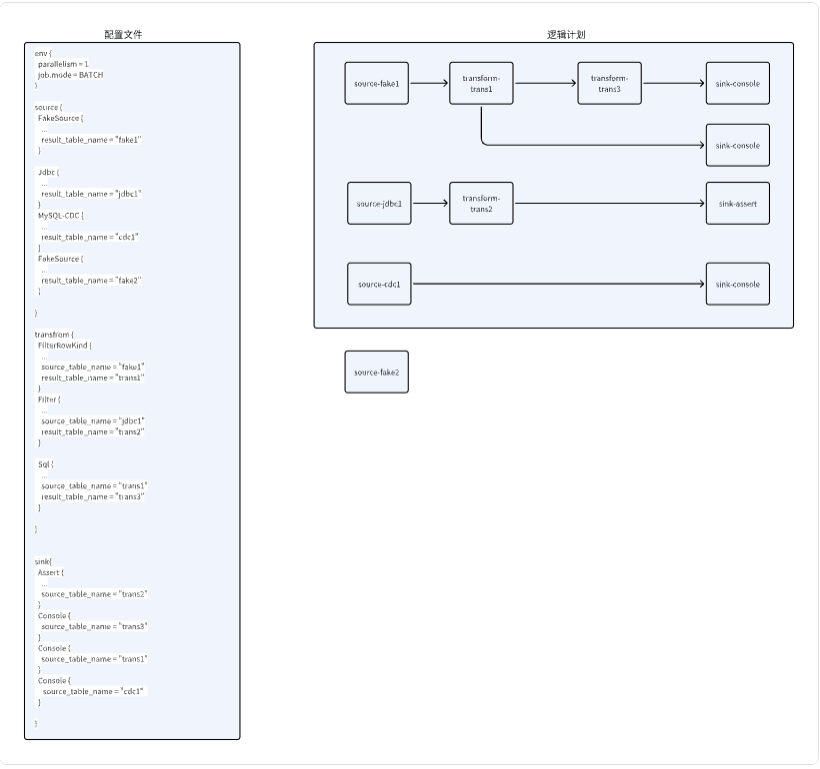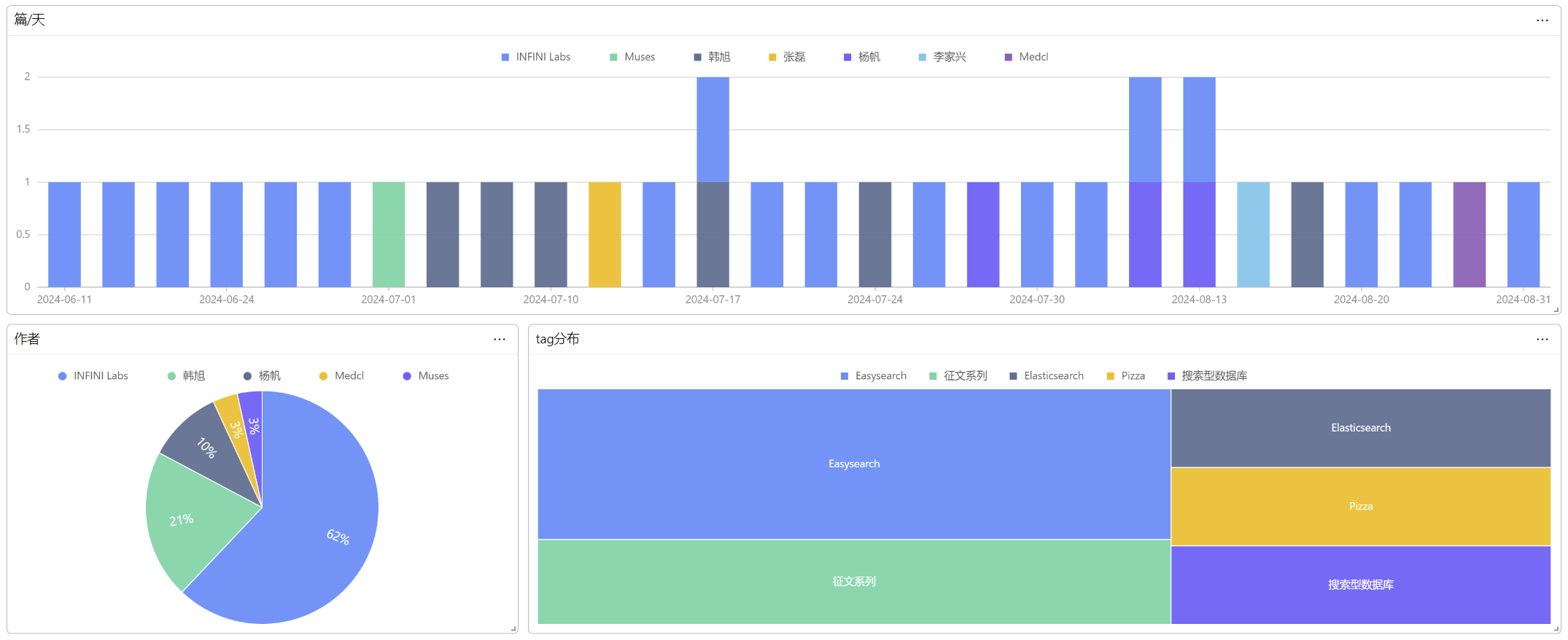作者:刘乃杰
编辑整理:曾辉
引入
本系列文章是基于 Apache SeaTunnel 2.3.6版本,围绕Zeta引擎给大家介绍其任务是如何从提交到运行的全流程,希望通过这篇文档,对刚刚上手SeaTunnel的朋友提供一些帮助。

我们整体的文章将会分成三篇,从以下方向给大家介绍:
- SeaTunnel Server端的初始化
- Client端的任务提交流程
- Server端的接收到任务的执行流程
由于涉及源码解析,涉及篇幅较大,所以分成系列文章来记录下一个任务的整体流程。
参考
- [ST-Engine][Design] The Design of LogicalPlan to PhysicalPlan:https://github.com/apache/seatunnel/issues/2269
作者介绍
大家好,我是刘乃杰,一名大数据开发工程师,参与Apache SeaTunnel的开发也有一年多的时间了,不仅给SeaTunnel提交了一些PR,而且添加的一些功能也非常有意思,欢迎大家来找我交流,其中包括支持Avro格式文件,SQL Transform中支持嵌套结构查询,给节点添加Tag达到资源隔离等。
接之前的文章:
下面我们会再从一个简单的任务开始, 从客户端看下任务的提交流程。
客户端提交任务
这里以命令行提交任务的形式来讲解任务的提交流程。
命令行提交任务的命令为
./bin/seatunnel/sh -c <config_path>我们查看这个脚本文件后可以看到这个脚本中最后会调用org.apache.seatunnel.core.starter.seatunnel.SeaTunnelClient这个类
public class SeaTunnelClient {
public static void main(String[] args) throws CommandException {
ClientCommandArgs clientCommandArgs =
CommandLineUtils.parse(
args,
new ClientCommandArgs(),
EngineType.SEATUNNEL.getStarterShellName(),
true);
SeaTunnel.run(clientCommandArgs.buildCommand());
}
}在这个类中,仅有一个main方法, 与上面的server端的代码类似,不过这里构建的是ClientCommandArgs
解析命令行参数
我们查看clientCommandArgs.buildCommand方法
public Command<?> buildCommand() {
Common.setDeployMode(getDeployMode());
if (checkConfig) {
return new SeaTunnelConfValidateCommand(this);
}
if (encrypt) {
return new ConfEncryptCommand(this);
}
if (decrypt) {
return new ConfDecryptCommand(this);
}
return new ClientExecuteCommand(this);
}这里是调用了jcommander来解析参数, 会根据用户传递的参数来决定构建哪个类, 例如是对配置文件做检查,还是加密文件,解密文件以及是不是Client提交任务的命令。
这里就不再讲解其他几个类,主要来看下ClientExecuteCommand这个类的主要代码都在execute方法中, 整体方法比较长, 我将分段来描述每一段的作业
连接集群
在这一部分代码中, 做的事情是读取hazelcast-client.yaml文件,尝试建立与server端的连接, 当使用local模式时,会现在本地创建一个hazelcast的实例, 然后连接到这个实例上, 当使用cluster模式时, 则直接连接到集群上。
public void execute() throws CommandExecuteException {
JobMetricsRunner.JobMetricsSummary jobMetricsSummary = null;
LocalDateTime startTime = LocalDateTime.now();
LocalDateTime endTime = LocalDateTime.now();
SeaTunnelConfig seaTunnelConfig = ConfigProvider.locateAndGetSeaTunnelConfig();
try {
String clusterName = clientCommandArgs.getClusterName();
// 加载配置信息
ClientConfig clientConfig = ConfigProvider.locateAndGetClientConfig();
// 根据此次提交的任务类型,当使用local模式时,意味着上面服务端的流程是没有执行的,
// 所以先创建一个本地seatunnel server
if (clientCommandArgs.getMasterType().equals(MasterType.LOCAL)) {
clusterName =
creatRandomClusterName(
StringUtils.isNotEmpty(clusterName)
? clusterName
: Constant.DEFAULT_SEATUNNEL_CLUSTER_NAME);
instance = createServerInLocal(clusterName, seaTunnelConfig);
int port = instance.getCluster().getLocalMember().getSocketAddress().getPort();
clientConfig
.getNetworkConfig()
.setAddresses(Collections.singletonList("localhost:" + port));
}
// 与远程或本地的seatunnel server连接,创建一个engineClient
if (StringUtils.isNotEmpty(clusterName)) {
seaTunnelConfig.getHazelcastConfig().setClusterName(clusterName);
clientConfig.setClusterName(clusterName);
}
engineClient = new SeaTunnelClient(clientConfig);
// 省略第二段代码
// 省略第三段代码
}
} catch (Exception e) {
throw new CommandExecuteException("SeaTunnel job executed failed", e);
} finally {
if (jobMetricsSummary != null) {
// 任务结束,打印日志
log.info(
StringFormatUtils.formatTable(
"Job Statistic Information",
"Start Time",
DateTimeUtils.toString(
startTime, DateTimeUtils.Formatter.YYYY_MM_DD_HH_MM_SS),
"End Time",
DateTimeUtils.toString(
endTime, DateTimeUtils.Formatter.YYYY_MM_DD_HH_MM_SS),
"Total Time(s)",
Duration.between(startTime, endTime).getSeconds(),
"Total Read Count",
jobMetricsSummary.getSourceReadCount(),
"Total Write Count",
jobMetricsSummary.getSinkWriteCount(),
"Total Failed Count",
jobMetricsSummary.getSourceReadCount()
- jobMetricsSummary.getSinkWriteCount()));
}
closeClient();
}
}
判断任务类型,调用相关方法
则是根据用户的参数来判断这次的任务类型是什么, 根据参数的不同,调用不同的方法。
例如取消任务, 则会调用相应的取消任务方法, 这次对这里的几个任务不再具体分析, 这次以提交任务为主, 当我们将提交任务的流程弄明白, 这些再去看时也就简单了。
if (clientCommandArgs.isListJob()) {
String jobStatus = engineClient.getJobClient().listJobStatus(true);
System.out.println(jobStatus);
} else if (clientCommandArgs.isGetRunningJobMetrics()) {
String runningJobMetrics = engineClient.getJobClient().getRunningJobMetrics();
System.out.println(runningJobMetrics);
} else if (null != clientCommandArgs.getJobId()) {
String jobState =
engineClient
.getJobClient()
.getJobDetailStatus(Long.parseLong(clientCommandArgs.getJobId()));
System.out.println(jobState);
} else if (null != clientCommandArgs.getCancelJobId()) {
engineClient
.getJobClient()
.cancelJob(Long.parseLong(clientCommandArgs.getCancelJobId()));
} else if (null != clientCommandArgs.getMetricsJobId()) {
String jobMetrics =
engineClient
.getJobClient()
.getJobMetrics(Long.parseLong(clientCommandArgs.getMetricsJobId()));
System.out.println(jobMetrics);
} else if (null != clientCommandArgs.getSavePointJobId()) {
engineClient
.getJobClient()
.savePointJob(Long.parseLong(clientCommandArgs.getSavePointJobId()));
} else {
// 省略第三段代码提交任务到集群
// 获取配置文件的路径, 并检查文件是否存在
Path configFile = FileUtils.getConfigPath(clientCommandArgs);
checkConfigExist(configFile);
JobConfig jobConfig = new JobConfig();
// 下面会根据这次任务是根据savepoint重启还是启动新任务来调用不同的方法来构建ClientJobExecutionEnvironment对象
ClientJobExecutionEnvironment jobExecutionEnv;
jobConfig.setName(clientCommandArgs.getJobName());
if (null != clientCommandArgs.getRestoreJobId()) {
jobExecutionEnv =
engineClient.restoreExecutionContext(
configFile.toString(),
clientCommandArgs.getVariables(),
jobConfig,
seaTunnelConfig,
Long.parseLong(clientCommandArgs.getRestoreJobId()));
} else {
jobExecutionEnv =
engineClient.createExecutionContext(
configFile.toString(),
clientCommandArgs.getVariables(),
jobConfig,
seaTunnelConfig,
clientCommandArgs.getCustomJobId() != null
? Long.parseLong(clientCommandArgs.getCustomJobId())
: null);
}
// get job start time
startTime = LocalDateTime.now();
// create job proxy
// 提交任务
ClientJobProxy clientJobProxy = jobExecutionEnv.execute();
// 判断是否为异步提交,当异步提交时会直接退出,不进行状态检查
if (clientCommandArgs.isAsync()) {
if (clientCommandArgs.getMasterType().equals(MasterType.LOCAL)) {
log.warn("The job is running in local mode, can not use async mode.");
} else {
return;
}
}
// register cancelJob hook
// 添加hook方法, 当提交完成任务后, 命令行退出时, 取消刚刚提交的任务
Runtime.getRuntime()
.addShutdownHook(
new Thread(
() -> {
CompletableFuture<Void> future =
CompletableFuture.runAsync(
() -> {
log.info(
"run shutdown hook because get close signal");
shutdownHook(clientJobProxy);
});
try {
future.get(15, TimeUnit.SECONDS);
} catch (Exception e) {
log.error("Cancel job failed.", e);
}
}));
// 同步,检查任务状态相关代码
// 获取任务id, 然后启动后台线程定时检查任务状态
long jobId = clientJobProxy.getJobId();
JobMetricsRunner jobMetricsRunner = new JobMetricsRunner(engineClient, jobId);
// 创建线程,定时检查状态
executorService =
Executors.newSingleThreadScheduledExecutor(
new ThreadFactoryBuilder()
.setNameFormat("job-metrics-runner-%d")
.setDaemon(true)
.build());
executorService.scheduleAtFixedRate(
jobMetricsRunner,
0,
seaTunnelConfig.getEngineConfig().getPrintJobMetricsInfoInterval(),
TimeUnit.SECONDS);
// wait for job complete
// 等待任务结束, 检查任务状态,当任务为异常退出时, 抛出异常
JobResult jobResult = clientJobProxy.waitForJobCompleteV2();
jobStatus = jobResult.getStatus();
if (StringUtils.isNotEmpty(jobResult.getError())
|| jobResult.getStatus().equals(JobStatus.FAILED)) {
throw new SeaTunnelEngineException(jobResult.getError());
}
// get job end time
endTime = LocalDateTime.now();
// get job statistic information when job finished
jobMetricsSummary = engineClient.getJobMetricsSummary(jobId); 下面我们就看下jobExecutionEnv这个类的初始化与execute方法
public ClientJobExecutionEnvironment(
JobConfig jobConfig,
String jobFilePath,
List<String> variables,
SeaTunnelHazelcastClient seaTunnelHazelcastClient,
SeaTunnelConfig seaTunnelConfig,
boolean isStartWithSavePoint,
Long jobId) {
super(jobConfig, isStartWithSavePoint);
this.jobFilePath = jobFilePath;
this.variables = variables;
this.seaTunnelHazelcastClient = seaTunnelHazelcastClient;
this.jobClient = new JobClient(seaTunnelHazelcastClient);
this.seaTunnelConfig = seaTunnelConfig;
Long finalJobId;
if (isStartWithSavePoint || jobId != null) {
finalJobId = jobId;
} else {
finalJobId = jobClient.getNewJobId();
}
this.jobConfig.setJobContext(new JobContext(finalJobId));
this.connectorPackageClient = new ConnectorPackageClient(seaTunnelHazelcastClient);
}这个类的初始化中,很简单,只是变量赋值操作,没有做其他初始化操作。再来看下execute方法
public ClientJobProxy execute() throws ExecutionException, InterruptedException {
LogicalDag logicalDag = getLogicalDag();
log.info(
"jarUrls is : [{}]",
jarUrls.stream().map(URL::getPath).collect(Collectors.joining(", ")));
JobImmutableInformation jobImmutableInformation =
new JobImmutableInformation(
Long.parseLong(jobConfig.getJobContext().getJobId()),
jobConfig.getName(),
isStartWithSavePoint,
seaTunnelHazelcastClient.getSerializationService().toData(logicalDag),
jobConfig,
new ArrayList<>(jarUrls),
new ArrayList<>(connectorJarIdentifiers));
return jobClient.createJobProxy(jobImmutableInformation);
}这个方法中,先调用getLogicalDag生产了逻辑计划,然后构建JobImmutableInformation 信息,传递给jobClient,我们先看后面的步骤,等会再看如何生成的逻辑计划。
public ClientJobProxy createJobProxy(@NonNull JobImmutableInformation jobImmutableInformation) {
return new ClientJobProxy(hazelcastClient, jobImmutableInformation);
}
public ClientJobProxy(
@NonNull SeaTunnelHazelcastClient seaTunnelHazelcastClient,
@NonNull JobImmutableInformation jobImmutableInformation) {
this.seaTunnelHazelcastClient = seaTunnelHazelcastClient;
this.jobId = jobImmutableInformation.getJobId();
submitJob(jobImmutableInformation);
}
private void submitJob(JobImmutableInformation jobImmutableInformation) {
LOGGER.info(
String.format(
"Start submit job, job id: %s, with plugin jar %s",
jobImmutableInformation.getJobId(),
jobImmutableInformation.getPluginJarsUrls()));
ClientMessage request =
SeaTunnelSubmitJobCodec.encodeRequest(
jobImmutableInformation.getJobId(),
seaTunnelHazelcastClient
.getSerializationService()
.toData(jobImmutableInformation),
jobImmutableInformation.isStartWithSavePoint());
PassiveCompletableFuture<Void> submitJobFuture =
seaTunnelHazelcastClient.requestOnMasterAndGetCompletableFuture(request);
submitJobFuture.join();
LOGGER.info(
String.format(
"Submit job finished, job id: %s, job name: %s",
jobImmutableInformation.getJobId(), jobImmutableInformation.getJobName()));
}在这里的代码可以看到,生成JobImmutableInformation后,会将这个信息转换为ClientMessage(SeaTunnelSubmitJobCodec)然后发送给Master节点,也就是hazelcast server中的master节点。
提交完成之后又回到上面的任务状态检测相关步骤。
这里的消息发送是调用了Hazelcast的相关方法,我们对其的实现不需要关注。
逻辑计划解析
最后一篇文章会再回到Server端看下当收到client端发送的提交任务后的处理逻辑,这里我们先回到前面,看下在客户端如何生成的逻辑计划。
LogicalDag logicalDag = getLogicalDag();先看下LogicalDag的结构
@Getter private JobConfig jobConfig;
private final Set<LogicalEdge> edges = new LinkedHashSet<>();
private final Map<Long, LogicalVertex> logicalVertexMap = new LinkedHashMap<>();
private IdGenerator idGenerator;
private boolean isStartWithSavePoint = false;在这个类里有这几个变量,有两个比较关键的类LogicalEdge和LogicalVertex,通过任务之间的关联关联构建出DAG。
LogicalEdge的类中存储的变量很简单, 存储了两个点的关系。
/** The input vertex connected to this edge. */
private LogicalVertex inputVertex;
/** The target vertex connected to this edge. */
private LogicalVertex targetVertex;
private Long inputVertexId;
private Long targetVertexId;LogicalVertex的变量为这几个变量,有当前点的编号,以及所需的并行度,以及Action接口, Action接口会有SourceAction,SinkAction,TransformAction等不同的实现类。
private Long vertexId;
private Action action;
/** Number of subtasks to split this task into at runtime. */
private int parallelism;看下getLogicalDag的方法
public LogicalDag getLogicalDag() {
//
ImmutablePair<List<Action>, Set<URL>> immutablePair = getJobConfigParser().parse(null);
actions.addAll(immutablePair.getLeft());
// seatunnel有个功能是不需要服务端所有节点有全部的依赖,可以在客户端中将所需依赖上传到服务端
// 这里的if-else是这个功能的一些逻辑判断,判断是否需要从客户端将jar包上传到服务端,从而服务端不需要维护全部的jar包
boolean enableUploadConnectorJarPackage =
seaTunnelConfig.getEngineConfig().getConnectorJarStorageConfig().getEnable();
if (enableUploadConnectorJarPackage) {
Set<ConnectorJarIdentifier> commonJarIdentifiers =
connectorPackageClient.uploadCommonPluginJars(
Long.parseLong(jobConfig.getJobContext().getJobId()), commonPluginJars);
Set<URL> commonPluginJarUrls = getJarUrlsFromIdentifiers(commonJarIdentifiers);
Set<ConnectorJarIdentifier> pluginJarIdentifiers = new HashSet<>();
uploadActionPluginJar(actions, pluginJarIdentifiers);
Set<URL> connectorPluginJarUrls = getJarUrlsFromIdentifiers(pluginJarIdentifiers);
connectorJarIdentifiers.addAll(commonJarIdentifiers);
connectorJarIdentifiers.addAll(pluginJarIdentifiers);
jarUrls.addAll(commonPluginJarUrls);
jarUrls.addAll(connectorPluginJarUrls);
actions.forEach(
action -> {
addCommonPluginJarsToAction(
action, commonPluginJarUrls, commonJarIdentifiers);
});
} else {
jarUrls.addAll(commonPluginJars);
jarUrls.addAll(immutablePair.getRight());
actions.forEach(
action -> {
addCommonPluginJarsToAction(
action, new HashSet<>(commonPluginJars), Collections.emptySet());
});
}
return getLogicalDagGenerator().generate();
}方法中首先调用了.parse(null)方法,此方法的返回值是一个不可变二元组,第一个值为List<Action>对象,getJobConfigParser返回的对象是MultipleTableJobConfigParser
public MultipleTableJobConfigParser(
Config seaTunnelJobConfig,
IdGenerator idGenerator,
JobConfig jobConfig,
List<URL> commonPluginJars,
boolean isStartWithSavePoint) {
this.idGenerator = idGenerator;
this.jobConfig = jobConfig;
this.commonPluginJars = commonPluginJars;
this.isStartWithSavePoint = isStartWithSavePoint;
this.seaTunnelJobConfig = seaTunnelJobConfig;
this.envOptions = ReadonlyConfig.fromConfig(seaTunnelJobConfig.getConfig("env"));
this.fallbackParser =
new JobConfigParser(idGenerator, commonPluginJars, this, isStartWithSavePoint);
}当调用parse(null)方法时,会进行解析
public ImmutablePair<List<Action>, Set<URL>> parse(ClassLoaderService classLoaderService) {
// 将配置文件中的 env.jars添加到 commonJars中
this.fillJobConfigAndCommonJars();
// 从配置文件中,将source,transform,sink的配置分别读取处理
List<? extends Config> sourceConfigs =
TypesafeConfigUtils.getConfigList(
seaTunnelJobConfig, "source", Collections.emptyList());
List<? extends Config> transformConfigs =
TypesafeConfigUtils.getConfigList(
seaTunnelJobConfig, "transform", Collections.emptyList());
List<? extends Config> sinkConfigs =
TypesafeConfigUtils.getConfigList(
seaTunnelJobConfig, "sink", Collections.emptyList());
// 获取连接器的jar包地址
List<URL> connectorJars = getConnectorJarList(sourceConfigs, sinkConfigs);
if (!commonPluginJars.isEmpty()) {
// 将commonJars添加到连接器的jars中
connectorJars.addAll(commonPluginJars);
}
ClassLoader parentClassLoader = Thread.currentThread().getContextClassLoader();
ClassLoader classLoader;
if (classLoaderService == null) {
// 由于我们刚才传递了null,所以这里会创建SeaTunnelChildFirstClassLoader类加载器
// 从名字也能看出,这里会与默认的加载器不同,不会先调用父类进行加载,
// 而是自己找不到之后再调用父类进行加载,避免jar包冲突
classLoader = new SeaTunnelChildFirstClassLoader(connectorJars, parentClassLoader);
} else {
classLoader =
classLoaderService.getClassLoader(
Long.parseLong(jobConfig.getJobContext().getJobId()), connectorJars);
}
try {
Thread.currentThread().setContextClassLoader(classLoader);
// 检查DAG里面是否构成环,避免后续的构建过程陷入循环
ConfigParserUtil.checkGraph(sourceConfigs, transformConfigs, sinkConfigs);
LinkedHashMap<String, List<Tuple2<CatalogTable, Action>>> tableWithActionMap =
new LinkedHashMap<>();
log.info("start generating all sources.");
for (int configIndex = 0; configIndex < sourceConfigs.size(); configIndex++) {
Config sourceConfig = sourceConfigs.get(configIndex);
// parseSource方法为真正生成source的方法
// 返回值为2元组,第一个值为 当前source生成的表名称
// 第二个值为 CatalogTable和Action的二元组列表
// 由于SeaTunnel Source支持读取多表,所以第二个值为列表
Tuple2<String, List<Tuple2<CatalogTable, Action>>> tuple2 =
parseSource(configIndex, sourceConfig, classLoader);
tableWithActionMap.put(tuple2._1(), tuple2._2());
}
log.info("start generating all transforms.");
// parseTransforms来生成transform
// 这里将上面的 tableWithActionMap传递了进去,所以不需要返回值
parseTransforms(transformConfigs, classLoader, tableWithActionMap);
log.info("start generating all sinks.");
List<Action> sinkActions = new ArrayList<>();
for (int configIndex = 0; configIndex < sinkConfigs.size(); configIndex++) {
Config sinkConfig = sinkConfigs.get(configIndex);
// parseSink方法来生成sink
// 同样,传递了tableWithActionMap
sinkActions.addAll(
parseSink(configIndex, sinkConfig, classLoader, tableWithActionMap));
}
Set<URL> factoryUrls = getUsedFactoryUrls(sinkActions);
return new ImmutablePair<>(sinkActions, factoryUrls);
} finally {
// 将当前线程的类加载器切换为原来的类加载器
Thread.currentThread().setContextClassLoader(parentClassLoader);
if (classLoaderService != null) {
classLoaderService.releaseClassLoader(
Long.parseLong(jobConfig.getJobContext().getJobId()), connectorJars);
}
}
}解析Source
先来看下parseSource方法
public Tuple2<String, List<Tuple2<CatalogTable, Action>>> parseSource(
int configIndex, Config sourceConfig, ClassLoader classLoader) {
final ReadonlyConfig readonlyConfig = ReadonlyConfig.fromConfig(sourceConfig);
// factoryId就是我们配置里面的 source名称,例如 FakeSource, Jdbc
final String factoryId = getFactoryId(readonlyConfig);
// 获取当前数据源生成的 表 名称,注意这里的表可能并不对应一个表
// 由于 seatunnel source支持多表读取,那么这里就会出现一对多的关系
final String tableId =
readonlyConfig.getOptional(CommonOptions.RESULT_TABLE_NAME).orElse(DEFAULT_ID);
// 获取并行度
final int parallelism = getParallelism(readonlyConfig);
// 这个地方是由于某些Source还不支持通过Factory工厂来构建,所以会有两种构建方法
// 后续当所有连接器都支持通过工厂来创建后,这里的代码会被删除掉,所以这次忽略掉这部分代码
// 方法内部是查询是否有相应的工厂类,相应的工厂类不存在时返回 true,不存在时返回false
boolean fallback =
isFallback(
classLoader,
TableSourceFactory.class,
factoryId,
(factory) -> factory.createSource(null));
if (fallback) {
Tuple2<CatalogTable, Action> tuple =
fallbackParser.parseSource(sourceConfig, jobConfig, tableId, parallelism);
return new Tuple2<>(tableId, Collections.singletonList(tuple));
}
// 通过FactoryUtil来创建Source
// 返回对象为 SeaTunnelSource实例,以及List<CatalogTable>
// 这里会创建我们同步任务中Source的实例,catalogtable列表表示这个数据源读取的表的表结构等信息
Tuple2<SeaTunnelSource<Object, SourceSplit, Serializable>, List<CatalogTable>> tuple2 =
FactoryUtil.createAndPrepareSource(readonlyConfig, classLoader, factoryId);
// 获取当前source connector的jar包
Set<URL> factoryUrls = new HashSet<>();
factoryUrls.addAll(getSourcePluginJarPaths(sourceConfig));
List<Tuple2<CatalogTable, Action>> actions = new ArrayList<>();
long id = idGenerator.getNextId();
String actionName = JobConfigParser.createSourceActionName(configIndex, factoryId);
SeaTunnelSource<Object, SourceSplit, Serializable> source = tuple2._1();
source.setJobContext(jobConfig.getJobContext());
PluginUtil.ensureJobModeMatch(jobConfig.getJobContext(), source);
// 构建 SourceAction
SourceAction<Object, SourceSplit, Serializable> action =
new SourceAction<>(id, actionName, tuple2._1(), factoryUrls, new HashSet<>());
action.setParallelism(parallelism);
for (CatalogTable catalogTable : tuple2._2()) {
actions.add(new Tuple2<>(catalogTable, action));
}
return new Tuple2<>(tableId, actions);
}看一下新版本中是如何通过工厂来创建Source实例的
public static <T, SplitT extends SourceSplit, StateT extends Serializable>
Tuple2<SeaTunnelSource<T, SplitT, StateT>, List<CatalogTable>> createAndPrepareSource(
ReadonlyConfig options, ClassLoader classLoader, String factoryIdentifier) {
try {
// 通过SPI加载TableSourceFactory的类,然后根据factoryIdentifier找对应的类
// 即 找到 souce对应的 SourceFactory
final TableSourceFactory factory =
discoverFactory(classLoader, TableSourceFactory.class, factoryIdentifier);
// 通过Factory来创建Source实例,这个Source实例就是你任务中对应类型的Source
// 也就是说Source类的初始化会在Client端创建一次,需要注意这里的环境是否能够连接到该Source
SeaTunnelSource<T, SplitT, StateT> source =
createAndPrepareSource(factory, options, classLoader);
List<CatalogTable> catalogTables;
try {
// 获取 source会产生的表 列表。包含了字段,数据类型,分区信息等
catalogTables = source.getProducedCatalogTables();
} catch (UnsupportedOperationException e) {
// 为了兼容有些Connector未实现getProducedCatalogTables方法
// 调用老的获取数据类型的方法,并转换为Catalog
SeaTunnelDataType<T> seaTunnelDataType = source.getProducedType();
final String tableId =
options.getOptional(CommonOptions.RESULT_TABLE_NAME).orElse(DEFAULT_ID);
catalogTables =
CatalogTableUtil.convertDataTypeToCatalogTables(seaTunnelDataType, tableId);
}
LOG.info(
"get the CatalogTable from source {}: {}",
source.getPluginName(),
catalogTables.stream()
.map(CatalogTable::getTableId)
.map(TableIdentifier::toString)
.collect(Collectors.joining(",")));
// 解析参数,当设置为 SHARDING 时,仅取第一个表结构
// 该参数没有文档介绍,没有设置,不清楚作用
if (options.get(SourceOptions.DAG_PARSING_MODE) == ParsingMode.SHARDING) {
CatalogTable catalogTable = catalogTables.get(0);
catalogTables.clear();
catalogTables.add(catalogTable);
}
return new Tuple2<>(source, catalogTables);
} catch (Throwable t) {
throw new FactoryException(
String.format(
"Unable to create a source for identifier '%s'.", factoryIdentifier),
t);
}
}
private static <T, SplitT extends SourceSplit, StateT extends Serializable>
SeaTunnelSource<T, SplitT, StateT> createAndPrepareSource(
TableSourceFactory factory, ReadonlyConfig options, ClassLoader classLoader) {
// 通过TableSourceFactory来创建Source
TableSourceFactoryContext context = new TableSourceFactoryContext(options, classLoader);
ConfigValidator.of(context.getOptions()).validate(factory.optionRule());
TableSource<T, SplitT, StateT> tableSource = factory.createSource(context);
return tableSource.createSource();
}在客户端就会通过SPI加载到Source相应的Factory然后创建出对应的Source实例出来,所以这里需要保证提交的客户端也能够与Source/Sink端建立连接,避免网络连不通的问题。
解析Transform
接下来在看一下如何创建Transform
public void parseTransforms(
List<? extends Config> transformConfigs,
ClassLoader classLoader,
LinkedHashMap<String, List<Tuple2<CatalogTable, Action>>> tableWithActionMap) {
if (CollectionUtils.isEmpty(transformConfigs) || transformConfigs.isEmpty()) {
return;
}
Queue<Config> configList = new LinkedList<>(transformConfigs);
int index = 0;
while (!configList.isEmpty()) {
parseTransform(index++, configList, classLoader, tableWithActionMap);
}
}
private void parseTransform(
int index,
Queue<Config> transforms,
ClassLoader classLoader,
LinkedHashMap<String, List<Tuple2<CatalogTable, Action>>> tableWithActionMap) {
Config config = transforms.poll();
final ReadonlyConfig readonlyConfig = ReadonlyConfig.fromConfig(config);
final String factoryId = getFactoryId(readonlyConfig);
// get jar urls
Set<URL> jarUrls = new HashSet<>();
jarUrls.addAll(getTransformPluginJarPaths(config));
final List<String> inputIds = getInputIds(readonlyConfig);
// inputIds为source_table_name,根据这个值找到所依赖的上游source
// 目前Transform不支持对多表进行处理,所以如果所依赖的上游是多表,会抛出异常
List<Tuple2<CatalogTable, Action>> inputs =
inputIds.stream()
.map(tableWithActionMap::get)
.filter(Objects::nonNull)
.peek(
input -> {
if (input.size() > 1) {
throw new JobDefineCheckException(
"Adding transform to multi-table source is not supported.");
}
})
.flatMap(Collection::stream)
.collect(Collectors.toList());
// inputs为空,表明当前Transform节点找不到任何上游的节点
// 此时会有几种情况
if (inputs.isEmpty()) {
if (transforms.isEmpty()) {
// 未设置source_table_name,设置结果与之前不对应并且只有一个transform时
// 把最后一个source作为这个transform的上游表
inputs = findLast(tableWithActionMap);
} else {
// 所依赖的transform可能还没有创建,将本次的transform再放回队列中,后续再进行解析
transforms.offer(config);
return;
}
}
// 这次transform结果产生的表名称
final String tableId =
readonlyConfig.getOptional(CommonOptions.RESULT_TABLE_NAME).orElse(DEFAULT_ID);
// 获取上游source的Action
Set<Action> inputActions =
inputs.stream()
.map(Tuple2::_2)
.collect(Collectors.toCollection(LinkedHashSet::new));
// 验证所依赖的多个上游,是否产生的表结构都相同,只有所有的表结构都相同才能进入一个transform来处理
checkProducedTypeEquals(inputActions);
// 设置并行度
int spareParallelism = inputs.get(0)._2().getParallelism();
int parallelism =
readonlyConfig.getOptional(CommonOptions.PARALLELISM).orElse(spareParallelism);
// 创建Transform实例,与刚刚通过Source工厂来创建差不多的行为
CatalogTable catalogTable = inputs.get(0)._1();
SeaTunnelTransform<?> transform =
FactoryUtil.createAndPrepareTransform(
catalogTable, readonlyConfig, classLoader, factoryId);
transform.setJobContext(jobConfig.getJobContext());
long id = idGenerator.getNextId();
String actionName = JobConfigParser.createTransformActionName(index, factoryId);
// 封装成Action
TransformAction transformAction =
new TransformAction(
id,
actionName,
new ArrayList<>(inputActions),
transform,
jarUrls,
new HashSet<>());
transformAction.setParallelism(parallelism);
// 放入到map中,此时map里面存储了source和transform
// 以每个节点产生的表结构为key,action作为value
tableWithActionMap.put(
tableId,
Collections.singletonList(
new Tuple2<>(transform.getProducedCatalogTable(), transformAction)));
}解析Sink
当看完Source/transform的解析之后,对于Sink的解析逻辑也会比较明了。
public List<SinkAction<?, ?, ?, ?>> parseSink(
int configIndex,
Config sinkConfig,
ClassLoader classLoader,
LinkedHashMap<String, List<Tuple2<CatalogTable, Action>>> tableWithActionMap) {
ReadonlyConfig readonlyConfig = ReadonlyConfig.fromConfig(sinkConfig);
//
String factoryId = getFactoryId(readonlyConfig);
// 获取当前sink节点依赖的上游节点
List<String> inputIds = getInputIds(readonlyConfig);
// 在tableWithActionMap中查找
List<List<Tuple2<CatalogTable, Action>>> inputVertices =
inputIds.stream()
.map(tableWithActionMap::get)
.filter(Objects::nonNull)
.collect(Collectors.toList());
// 当sink节点找不到上游节点时,找到最后一个节点信息作为上游节点
// 这里与transform不一样的地方是,不会再等其他sink节点初始化完成,因为sink节点不可能依赖与其他sink节点
if (inputVertices.isEmpty()) {
// Tolerates incorrect configuration of simple graph
inputVertices = Collections.singletonList(findLast(tableWithActionMap));
} else if (inputVertices.size() > 1) {
for (List<Tuple2<CatalogTable, Action>> inputVertex : inputVertices) {
if (inputVertex.size() > 1) {
// 当一个sink节点即有多个上游节点,且某个上游节点还会产生多表时抛出异常
// sink可以支持多个数据源,或者单个数据源下产生多表,不能同时支持多个数据源,且某个数据源下存在多表
throw new JobDefineCheckException(
"Sink don't support simultaneous writing of data from multi-table source and other sources.");
}
}
}
// 与解析source一样,对老代码的兼容
boolean fallback =
isFallback(
classLoader,
TableSinkFactory.class,
factoryId,
(factory) -> factory.createSink(null));
if (fallback) {
return fallbackParser.parseSinks(configIndex, inputVertices, sinkConfig, jobConfig);
}
// 获取sink的连接器jar包
Set<URL> jarUrls = new HashSet<>();
jarUrls.addAll(getSinkPluginJarPaths(sinkConfig));
List<SinkAction<?, ?, ?, ?>> sinkActions = new ArrayList<>();
// 多个数据源的情况
if (inputVertices.size() > 1) {
Set<Action> inputActions =
inputVertices.stream()
.flatMap(Collection::stream)
.map(Tuple2::_2)
.collect(Collectors.toCollection(LinkedHashSet::new));
// 检查多个上游数据源产生的表结构是否一致
checkProducedTypeEquals(inputActions);
// 创建sinkAction
Tuple2<CatalogTable, Action> inputActionSample = inputVertices.get(0).get(0);
SinkAction<?, ?, ?, ?> sinkAction =
createSinkAction(
inputActionSample._1(),
inputActions,
readonlyConfig,
classLoader,
jarUrls,
new HashSet<>(),
factoryId,
inputActionSample._2().getParallelism(),
configIndex);
sinkActions.add(sinkAction);
return sinkActions;
}
// 此时只有一个数据源,且此数据源下可能会产生多表,循环创建sinkAction
for (Tuple2<CatalogTable, Action> tuple : inputVertices.get(0)) {
SinkAction<?, ?, ?, ?> sinkAction =
createSinkAction(
tuple._1(),
Collections.singleton(tuple._2()),
readonlyConfig,
classLoader,
jarUrls,
new HashSet<>(),
factoryId,
tuple._2().getParallelism(),
configIndex);
sinkActions.add(sinkAction);
}
// 当一个数据源下多表时与多个数据源 会多进行这么这一步
// 上面的createSinkAction是一致的
// 此方法内会判断sink是否支持多表,以及
Optional<SinkAction<?, ?, ?, ?>> multiTableSink =
tryGenerateMultiTableSink(
sinkActions, readonlyConfig, classLoader, factoryId, configIndex);
// 最终会将所创建的sink action作为返回值返回
return multiTableSink
.<List<SinkAction<?, ?, ?, ?>>>map(Collections::singletonList)
.orElse(sinkActions);
}接下来看下创建sinkAction方法
private SinkAction<?, ?, ?, ?> createSinkAction(
CatalogTable catalogTable,
Set<Action> inputActions,
ReadonlyConfig readonlyConfig,
ClassLoader classLoader,
Set<URL> factoryUrls,
Set<ConnectorJarIdentifier> connectorJarIdentifiers,
String factoryId,
int parallelism,
int configIndex) {
// 使用工厂类创建sink
SeaTunnelSink<?, ?, ?, ?> sink =
FactoryUtil.createAndPrepareSink(
catalogTable, readonlyConfig, classLoader, factoryId);
sink.setJobContext(jobConfig.getJobContext());
SinkConfig actionConfig =
new SinkConfig(catalogTable.getTableId().toTablePath().toString());
long id = idGenerator.getNextId();
String actionName =
JobConfigParser.createSinkActionName(
configIndex, factoryId, actionConfig.getMultipleRowTableId());
// 创建sinkAction
SinkAction<?, ?, ?, ?> sinkAction =
new SinkAction<>(
id,
actionName,
new ArrayList<>(inputActions),
sink,
factoryUrls,
connectorJarIdentifiers,
actionConfig);
if (!isStartWithSavePoint) {
// 这里需要注意,当非从savepoint启动时,会进行savemode的处理
handleSaveMode(sink);
}
sinkAction.setParallelism(parallelism);
return sinkAction;
}
public void handleSaveMode(SeaTunnelSink<?, ?, ?, ?> sink) {
// 当sink类支持了savemode特性时,会进行savemode处理
// 例如删除表,重建表,报错等
if (SupportSaveMode.class.isAssignableFrom(sink.getClass())) {
SupportSaveMode saveModeSink = (SupportSaveMode) sink;
// 当 设置savemode在client端执行时,会在client端去做这些事
// 我们之前出现过一个错误是当在客户端执行完毕后,到集群后任务执行出错,卡在scheduling的状态
// 导致数据被清空后没有及时写入
// 以及需要注意这个地方执行的机器到sink集群的网络是否能够连通,推荐将这个行为放到server端执行
if (envOptions
.get(EnvCommonOptions.SAVEMODE_EXECUTE_LOCATION)
.equals(SaveModeExecuteLocation.CLIENT)) {
log.warn(
"SaveMode execute location on CLIENT is deprecated, please use CLUSTER instead.");
Optional<SaveModeHandler> saveModeHandler = saveModeSink.getSaveModeHandler();
if (saveModeHandler.isPresent()) {
try (SaveModeHandler handler = saveModeHandler.get()) {
new SaveModeExecuteWrapper(handler).execute();
} catch (Exception e) {
throw new SeaTunnelRuntimeException(HANDLE_SAVE_MODE_FAILED, e);
}
}
}
}
}我们看完了如何去解析Source/Transform/Sink的逻辑,再回到调用的地方
List<Action> sinkActions = new ArrayList<>();
for (int configIndex = 0; configIndex < sinkConfigs.size(); configIndex++) {
Config sinkConfig = sinkConfigs.get(configIndex);
// parseSink方法来生成sink
// 同样,传递了tableWithActionMap
sinkActions.addAll(
parseSink(configIndex, sinkConfig, classLoader, tableWithActionMap));
}
Set<URL> factoryUrls = getUsedFactoryUrls(sinkActions);
return new ImmutablePair<>(sinkActions, factoryUrls);parseSink会返回所有创建的Sink Action,而每个Action都维护了upstream Action,所以我们能通过最终的Sink Action找到相关联的Transform Action和Source Action
最终调用getUsedFactoryUrls或找到此链路上的所有依赖的Jar,然后返回一个二元组。
逻辑计划解析
再回到逻辑计划生成的部分
public LogicalDag getLogicalDag() {
//
ImmutablePair<List<Action>, Set<URL>> immutablePair = getJobConfigParser().parse(null);
actions.addAll(immutablePair.getLeft());
....
return getLogicalDagGenerator().generate();
}在上面看完了如何去解析配置,接下来看下如何去生成逻辑计划
// 初始化将我们生成的所有SinkAction传入
protected LogicalDagGenerator getLogicalDagGenerator() {
return new LogicalDagGenerator(actions, jobConfig, idGenerator, isStartWithSavePoint);
}
public LogicalDag generate() {
// 根据action来生成节点信息
actions.forEach(this::createLogicalVertex);
// 创建边
Set<LogicalEdge> logicalEdges = createLogicalEdges();
// 构建LogicalDag对象,并将解析的值设置到相应属性中
LogicalDag logicalDag = new LogicalDag(jobConfig, idGenerator);
logicalDag.getEdges().addAll(logicalEdges);
logicalDag.getLogicalVertexMap().putAll(logicalVertexMap);
logicalDag.setStartWithSavePoint(isStartWithSavePoint);
return logicalDag;
}创建逻辑计划节点
private void createLogicalVertex(Action action) {
// 获取当前action的id,判断当map中已经存在则返回
final Long logicalVertexId = action.getId();
if (logicalVertexMap.containsKey(logicalVertexId)) {
return;
}
// 对上游的依赖进行循环创建
// map对象的存储结构为:
// 当前节点的id为key
// value为一个list,存储下游使用到该节点的id编号
action.getUpstream()
.forEach(
inputAction -> {
createLogicalVertex(inputAction);
inputVerticesMap
.computeIfAbsent(
inputAction.getId(), id -> new LinkedHashSet<>())
.add(logicalVertexId);
});
// 最后创建当前节点的信息
final LogicalVertex logicalVertex =
new LogicalVertex(logicalVertexId, action, action.getParallelism());
// 注意这里有两个map
// 一个为inputVerticesMap,一个为logicalVertexMap
// inputVerticesMap中存储了节点之间的关系
// logicalVertexMap存储了节点编号与节点的关系
logicalVertexMap.put(logicalVertexId, logicalVertex);
}
private Set<LogicalEdge> createLogicalEdges() {
// 使用上面创建的两个map来创建边
return inputVerticesMap.entrySet().stream()
.map(
entry ->
entry.getValue().stream()
.map(
targetId ->
new LogicalEdge(
logicalVertexMap.get(
entry.getKey()),
logicalVertexMap.get(targetId)))
.collect(Collectors.toList()))
.flatMap(Collection::stream)
.collect(Collectors.toCollection(LinkedHashSet::new));
}
上面的配置中,会根据上下游关系生成这样的逻辑计划图,并且由于Fake2节点是没有任务下游的,并不会计入到逻辑计划中
小结一下
至此我们看完了在客户端如何完成一个任务的提交流程
小结一下:
- 首先会判断我们执行的模式,当我们是Local模式时,会在本机创建一个Server节点
- 然后在当前节点创建一个
Hazelcast节点,与Hazelcast集群进行连接,连接到集群或者刚刚启动的本地节点 - 接下来判断我们这次的任务类型来调用不同的方法
- 以提交任务为例,会解析配置文件,并进行逻辑计划解析,在逻辑计划解析时,会在提交的机器上创建
Source/Transform/Sink实例。并且去执行Savemode功能,有可能会建表,重建表,删除数据操作(当启用客户端执行时) - 当逻辑计划解析完成后,会将信息编码,然后通过
Hazelcast的集群通信功能,将信息发送给Server的Master节点
- 发送完成后,根据配置决定退出还是继续做任务状态的检测
- 程序添加
Hook配置,当客户端退出后取消刚刚提交的任务
本文完!
本文由 白鲸开源科技 提供发布支持!








![[001-03-007].第07节:Redis中的管道](https://i-blog.csdnimg.cn/direct/10cb4b14abb547eba4351777c9b089b4.png)









